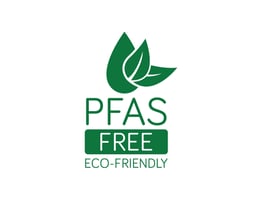Non-fluorinated water repellent clothing has become common in outdoor jackets over the past few...
Changes of PFC-free (fluorine-free or C0 water repellent)?
Did you know that the water repellents used in outdoor clothing are changing now? Rain jackets that used to be water-repellent are now changing. Rain jackets are becoming less water-repellent. Of course, this is a change that is not desirable when viewed only from the local perspective of rain jackets, but it is a change that is desirable when viewed more as a global phenomenon.
In this Q&A, we will explain how this C0 water repellent flow (= PFC-free = fluorine-free) has changed the fabric and what we need to pay attention to.
*PFC-free, fluorine-free, PFAS-free, and C0 water repellency are strictly speaking different from each other, but in practical use, they all mean the same thing, so there is no problem in understanding that they are all organic fluorine compound-free water repellency.
What is PFC-free (= fluorine-free = C0) water repellent?
For decades we have been using fluorinated water repellents. We are now switching to water repellents that do not use fluorine. Fluorine itself exists in the earth's environment, but the fluorine developed to make water repellent is a compound that does not exist in the earth's environment. The fact that these have been dispersed into the global environment over many years of use has become a problem, and in recent years it has been pointed out that some substances may also have adverse effects on the human body and living organisms.
Substances with known adverse effects are now banned from production and use, but this has only been the case in very recent years. It has now been switched to fluorine compounds, which are more friendly to both the human body and the global environment. In the case of outdoor clothing, there is a history of the switch to mild fluorinated water repellents around 2015. (Note that the use of pre-2015 rain jackets does not necessarily have adverse effects on the human body.) On the other hand, there is a movement to stop the use of fluorine compounds altogether, and this time we are talking about fluorine-free products.
However, the switch to fluoride-free is painful in the short term because fluoride is far superior in terms of performance. We must face performance degradation. We are also developing to provide better water repellency without fluorine, but unfortunately it is not enough to match the previous performance, and users will need to take care of it more frequently, like washing and maintenance.
How long do PFC-free (no fluorine used) and PFC (fluorine used) water repellent last, respectively?
First of all, it is important to understand that water repellency, whether PFC-free or PFC water repellent, does not decrease simply by storing the product without use. In other words, water repellency only degrades with use.
This assumption makes it difficult to properly address the previous question. This is because performance degrades only with use, and the length of time you keep it will depend on how often and how much you use it. There is a significant difference between someone who frequently goes to the mountains every week and uses rainwear in a harsh mountain environment and someone who hikes occasionally.
Therefore, we have presented some comparative data, thinking that comparisons would be the best way to answer this question at the moment. We have published on our website comparative data on commonly used waterproofing sprays, water repellents sold in mountaineering supply stores, and even with cleaners.
The difference between PFC-free and PFC water repellent is about half that of PFC water repellent. Of course, there are assumptions to be made, and there are differences in performance even when PFC water repellents are used, so it depends on what the standard is, but it must be said that the current level of PFC-free water repellency is quite different compared to the highest level of PFC water repellency. Some manufacturers claim to be able to achieve the same level as conventional PFC water repellency, but this is because the original PFC water repellency level to be compared is low.
Because of this reality, the transition to PFC-free seems to be a disadvantage in the short term for us outdoor enthusiasts who have become accustomed to the high performance of PFC water repellency.
How harmful is PFC (fluorine-based) water repellent to the human body?
As it turns out, we have found toxicity in some PFCs, but that does not mean that they cause immediate health problems. The essential point that we and other manufacturers are working on is to reduce the use of artificially created PFCs, which have been dispersed into the global environment in large quantities due to the long-term use of PFCs.
Of course, it is not without health risks. But to be honest, we still don't understand PFCs very well, because there are so many different types of PFCs, and the amount of PFCs is so vast that only recently, after years of research, has there been a link to harm for the few types that used to be commonly consumed. However, there is still much work to be done. We know that a lot of PFCs can be harmful, but we don't know exactly how much of them is a problem. The current situation is still very uncertain. In fact, it is no exaggeration to say that trace amounts of PFC can be detected in the bodies of all of us. In fact, it is not an exaggeration to say that trace amounts of PFCs can be detected in the bodies of all of us.
In particular, this is a problem in the special case of people who previously worked in or lived near a PFC manufacturing plant. Such people tend to have much higher PFC levels in their blood than normal, and their health should be monitored. Even in this case, there is no immediate problem, but rather a situation that needs to be monitored over a longer period of time for abnormalities to occur. Now that substances that have the potential to remain in the human body and environment for longer periods of time are being regulated (not worldwide, it should be added), the point that although organofluorine compounds themselves are still being manufactured in developed countries, they are now safe on a different level than the kind of substances we used to use However, as mentioned above, there are many uncertainties. However, as mentioned above, there are many unknowns, and it cannot be said that they are 100% safe, so there is a movement to regulate all PFCs.
Is there any difference in damage to fabrics between PFC-free and PFC water repellent?
PFC-free water repellency is still in the improvement stage and may change in the future, but for now, we can say that it will not change.
This is because the presence or absence of fluorine does not change the damage to the fabric, and because the basic process is the same for both PFC-free and PFC water repellent.
What are some of the precautions that need to be taken when using PFC-free water repellency, such as washing, maintenance, etc.?
As mentioned above, water repellency degradation has occurred by not using fluorine. For example, water repellency with fluorine can repel not only water but also oil, making it a very good stain repellent. However, when water repellency is achieved without fluorine, it is difficult to repel oil, and not only is the water repellency degraded, but the stain resistance is also greatly degraded.
Currently, worldwide development is underway to achieve better water repellency without fluorine, but unfortunately, it has not reached the same level as water repellency with fluorine. Some manufacturers claim to have achieved the same level of development, but this is a commercial story based on a very limited number of tests, and the overall difference is overwhelming.
Unfortunately, it must be admitted that the fluorine-free water repellent performance is inferior to that of the past. Therefore, the recent trend among manufacturers is to solve this problem with the cooperation of users. Specifically, the point that the fluorocarbon fleece becomes easy to get dirty and the water repellent performance is inferior is to be solved through regular maintenance and care by the user.
Washing and water repellent reprocessing is more important than ever with fluorine-free products. More frequent and higher quality washing and water repellent treatments will be required.
What are the advantages of PFC-free water repellency?
For those of us who have become accustomed to PFC water repellency, as I have conveyed, the disadvantages are noticeable in the short term.
What are the advantages of PFC-free water repellency in this context?
In conclusion, by doing PFC-free water repellency we are fulfilling our environmental responsibility.
The compounds used in PFC are originally non-existent in the natural environment. Therefore, we are working to change them into substances that are easy to decompose or exist in the natural environment whenever possible.
There will be temporary pain involved in this process. We must face the short term disadvantages.
I have a similar impression of this issue to that of microplastics. Plastic is also something that does not exist in the earth's environment in the first place, so the current situation of it being scattered around the planet is undesirable. It is our necessary effort to reduce its use and collect it whenever possible.
Similarly, PFCs have been scattered around the global environment after years of use. Since PFC exists in an even smaller form than microplastics, it is difficult to recover and we have no choice but to wait for it to decompose, which will take a very long time. Therefore, what we can do now is to try to prevent further spreading PFCs in the global environment as much as possible. However, fluorine is not an easy substance to switch to because of its excellent properties. Therefore, it is hoped that we will gradually switch over to fluorine not in the medical and aviation fields, but in fields that are not directly related to life, such as clothing.
Finally: it is also questionable to consider all PFCs as harmful
There is one last story that needs to be mentioned. That is that it is questionable to view all PFCs as simply one color.
It is true that PFCs are man-made organic compounds, but only a small fraction of them have been found to be problematic. The problem has only recently become apparent after decades of research on the most commonly used ones, and most of the others are unknown. I agree that since they are unknown, they should be regulated from a precautionary standpoint. However, we should not take harmful substances and unknown substances together.
Perhaps this may sound contradictory to what has been said so far. However, as explained earlier, a small percentage of PFCs are very difficult to decompose, and once released into the environment, they take a long time to decompose, which is why they are considered a problem. If fluorine has good environmental degradability, it is better to use it while taking advantage of its characteristics, so that the comprehensive environmental impact is smaller. At the elemental level, fluorine is present in our surroundings in abundance, so if it has good degradability, the premise changes.
The fluorine-free movement must be promoted, but at the same time we must continue to investigate its toxicity and environmental impact, rather than denying the use of fluorine altogether.



